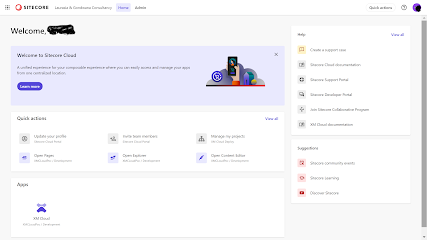Migrating from Sitecore XP to XM Cloud: A Developer’s Guide
Welcome to my new blog series! Over the next three posts, we'll explore the developer's journey of migrating from Sitecore XP to Sitecore XM Cloud. In this series, we’ll cover the analysis phase, and take a deep dive into the migration of media and content items.
As businesses strive to deliver more efficient and engaging digital experiences, Sitecore XM Cloud stands out as a robust solution — offering improved performance, high availability, reduced maintenance overhead, and automatic updates. It empowers organizations to modernize their digital infrastructure and deliver seamless experiences to end-users.
However, migration to XM Cloud isn’t a simple lift-and-shift. It requires careful planning, a deep understanding of your current setup, and a clearly defined strategy. In this first post, we’ll walk through the critical considerations that developers must keep in mind to ensure a smooth transition.
Audit Your Existing Sitecore XP Setup
Before you migrate, a thorough audit of your current environment is essential:
1. Sitecore Version & Modules
- Identify the current Sitecore version and any installed modules (e.g., Forms, Marketing Automation).
- These components can significantly influence migration complexity.
2. Custom Code & Integrations
-
Review all custom modules, pipelines, processors, commands, field types, and event handlers.
-
Document all inbound/outbound API integrations and assess their compatibility with XM Cloud.
3. Hosting Environment
-
Record details of your hosting setup — on-premises, PaaS, or hybrid.
-
Include hardware specs, OS, and database configurations.
4. Development Stack
-
Note the current development framework (.NET versions, MVC, rendering engines, or headless setup).
-
A headless approach can ease code migration.
5. Content & Template Architecture
-
Audit your content model, templates, and field configurations.
-
XM Cloud’s headless nature may require template restructuring or simplification.
6. Workflows & Publishing
-
Document custom workflows and approval processes.
-
XM Cloud’s simplified publishing may require workflow redesign.
7. Third-party & Legacy Systems
-
List integrations with CRMs, ERPs, eCommerce platforms, analytics, and marketing tools.
-
Identify any legacy systems that may not support API-first communication.
8. Digital Asset Management
-
Analyze current asset usage and storage.
-
XM Cloud often uses different CDNs or asset delivery methods — plan accordingly.
Choosing the Right Frontend Framework
XM Cloud is headless-first, and the frontend stack plays a critical role in performance and maintainability:
1. Recommended: Next.js
-
Sitecore recommends Next.js for its support of SSR, SSG, and ISR.
-
While frameworks like React or Angular can be used, they may require more configuration.
2. Performance & SEO
-
Next.js boosts performance through static generation and edge rendering.
-
Its built-in SSR enhances SEO — especially beneficial for content-heavy sites.
3. Team Skill Set
-
Choose a framework aligned with your development team’s skill set for faster adoption.
Understanding XM Cloud SaaS Capabilities
1. API-First Architecture
XM Cloud delivers content via GraphQL APIs through Experience Edge. Planning is required in several areas:
-
GraphQL schema design: Align current content types to GraphQL models.
-
Caching strategies: Understand and plan for Experience Edge’s behavior.
-
Error handling: Implement fallback mechanisms for API failures or partial content loads.
2. Development & Deployment Shifts
Migration involves adapting to XM Cloud’s SaaS-based development environment:
-
Local development: Use Sitecore CLI, containers, and serialization tools.
-
API-first model: Replace direct DB access and server-side integrations with APIs or webhooks.
-
CI/CD overhaul: Restructure deployment processes to align with XM Cloud's model.
-
Hosting: Evaluate platforms like Vercel, Netlify, or Azure Static Web Apps. Consider long-term cost, scalability, and team familiarity.
Migrating Content, Media, Forms & Personalization
1. Content Audit & Cleanup
-
Archive outdated items, remove duplicates, and streamline the content hierarchy.
-
Deeply nested templates and complex dependencies may need restructuring.
2. Content Serialization
-
Use Sitecore’s serialization tools to automate content export/import, reducing manual effort and error.
3. Content Transformation
-
Adjust field types and consolidate templates to match XM Cloud's streamlined data model.
4. Mapping & Validation
-
Map legacy content structures to headless models.
-
Run validation tests to ensure migration accuracy.
5. Media Asset Strategy
-
XM Cloud uses different CDN and media storage mechanisms.
-
Plan for migration, optimization, and cross-channel delivery.
6. xDB and Analytics
-
XM Cloud no longer supports xDB.
-
Plan to use Sitecore CDP, Google Analytics, or a custom CDP for behavioral tracking.
7. Personalization & A/B Testing
-
Evaluate if XM Cloud’s basic personalization is sufficient.
-
For advanced needs, consider integrating Sitecore Personalize.
-
A/B testing can be implemented using XM Cloud's native experimentation features.
Testing & Validation Strategy
Thorough testing ensures the stability and reliability of your new environment:
1. Integration Testing
-
Validate all feature migrations using end-to-end tests across APIs and services.
2. User Acceptance Testing (UAT)
-
Engage business users to test UI, content accuracy, and key workflows.
3. Performance Testing
-
Conduct load testing to ensure scalability and responsiveness under peak traffic.
4. SEO Testing
-
Verify all on-page SEO, structured data, meta tags, and sitemap integrations.
5. Security Testing
-
Test all APIs and data flows for vulnerabilities.
-
Ensure compliance with GDPR or other data protection standards.
Planning Your Migration
1. Phase-wise Rollout
-
Consider migrating in stages based on priority, complexity, or module dependency to reduce risk.
2. Risk Assessment
-
Plan for common risks:
-
Technical: Compatibility issues, integration challenges
-
Business: Training gaps, feature mismatches
-
Timeline: Scope creep, resource availability
-
Conclusion
Migrating to Sitecore XM Cloud is a transformational step — one that can significantly improve digital agility and performance. But to ensure a smooth migration, developers need to audit, plan, and test every stage of the process.
In the next blog, we’ll explore actual migration strategies and tools to help you move content, templates, and assets from XP to XM Cloud efficiently.




Comments
Post a Comment